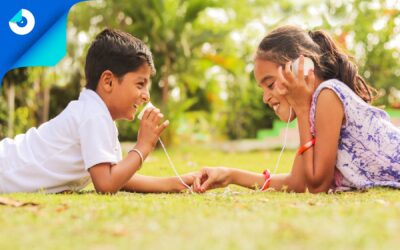Communication skills are one of the four essential skills for children as declared by the United Nations (UN) in the 21st century. Children’s communication cycle begins when they are toddlers, and they absorb information from their daily experiences and daily interaction. Sometimes, while delivering a speech, children might be confident but take longer pauses or sometimes they get very fluent but use a monotonous tone. So it becomes crucial for parents to understand that communication skills are not limited to just speaking fluently.
What are Communication Skills?
Communication skills encompass all of the skills needed to send and receive information effectively. These include not only speaking but also active listening, observing, and reacting. With the advent of the digital age, communication skills are no longer limited to face-to-face interactions, but they also include digital interactions via phone calls, emails, social media, etc.
Communication broadly consists of:
– Verbal Communication.
– Non-verbal Communication.
So parents need to ensure that their children pay equal attention to improving both types of communication.
How to improve the Communication Skills of your child?
Parents need to make sure their children follow the correct balance between both types of communication. And hence to achieve fluency in verbal communication and also to improve interpersonal skills, parents should ensure the following points:
Staying Confident
One of the significant aspects of verbal communication is to stay confident while delivering a speech. This way, one can build trust and reliability with the audience. As a result, the audience respects the speaker’s words.
To stay confident, one should master their subject content and a proper command of body posture and language.
Think and then speak
Children taking awkward pauses during a speech is a consequence of not correctly organizing the content. So writing down all the points and thoughts is a good habit.
But during impromptu speaking, this may not work. So children should take a minute to organize thoughts in their minds and then speak. This needs more and more practice and demo sessions as well.
Loud and clear speech
In a playful mood, children are usually loud. However, when they are giving a speech or speaking in front of an audience, their voice tone naturally becomes soft and dull. So to overcome this, parents should ensure that children avoid complex and confusing terms and answer everything confidently in direct and straightforward language.
Vocal tone adjustment
Children should be made aware that they shouldn’t sound monotonous during a speech. Instead, their delivery should ensure varying vocal tones as some words/phrases need to be pronounced with specific energy and tone. So, a varying vocal tone emphasizes the content’s critical sections, leading to better audience engagement.
Understanding the audience
It includes thinking about the audience’s perspective and being a good listener. Being a good listener is as vital as being a good speaker as it enhances two-way interactions. Listening includes: hearing, understanding, grasping, and evaluating. This way, the audience gets an idea that the speaker genuinely care about their points, which is very important.
Children are usually not good listeners, and hence this is a crucial point for them to consider to improve their communication skills.
Parents place a great deal of emphasis on verbal communication, but they usually neglect non-verbal communication. Non-verbal communication plays a significant role in establishing stronger relationships with others. It can enhance one’s ability to develop meaningful interactions in their daily life. It includes:
Gestures
A simple wave, pointing at something, or simply using hands while making a point or argument can be pretty impactful for expressing. Gestures are a significant part of communication, and they might mean something different to different cultures and hence should be used with utter care.
Facial expressions
Imagine a news reporter delivering the news without facial expressions, i.e., a blunt face. No matter how attractive the topic would be, would anyone be interested in the information? Not. Facial expressions matter a lot while delivering a speech, and that’s why class teachers emphasize this for the morning assemblies in school.
Body Posture
The way a person stands, walks, sits, etc., communicates a lot of information about them. So it does matter if the speaker is standing straight or leaning against something, or walking improperly when it comes to communication skills.
Eye contact
Eye contact is a crucial skill in non-verbal communication. It is essential to maintain conversation flow as just by looking at someone’s eyes; we can get a lot of information about the person like interest, attention, etc
Touch
One can gather different messages about someone from how they shake hands, a pat on the shoulder, and more such touches. Just like in school, children give a proper handshake to their close friends and a weak one to others which is not a good point in terms of communication.
Hence, a parent should inculcate habits so that children avoid misunderstandings, and be confident, which leads to smooth communication channels.
The Ministry of Education recently mandated Common University Entrance Examination (CUET-2022) as a common examination for undergraduate programs in more than 50 Central Universities, which got more than 11 lakh registrations and hence is considered as one of the biggest exams of the country. CUET has an entire section for testing student’s fluency in language(s). So it becomes vital for a student to be a confident speaker with a fluent language hold. Check out Orphicy’s Fluency course for developing communication skills among students.




